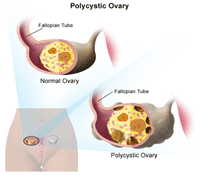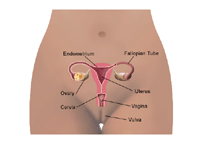Polycystic Ovary Syndrome (PCOS)
What is polycystic ovary syndrome (PCOS)?
Polycystic ovary syndrome (also called PCOS or Stein Leventhal syndrome) is the most common hormonal and reproductive problem affecting women of childbearing age. It's estimated that about 5 percent of women in the U.S. have this disorder.
 |
| Click Image to Enlarge |
PCOS has been defined as the presence of any two of the following characteristics:
-
Lack of ovulation for an extended period of time
-
High levels of androgens (male hormones)
-
Many small cysts (fluid-filled sacs) on the ovaries
What causes PCOS?
The exact cause of PCOS is unclear. It's common for sisters or a mother and daughter to have PCOS, but a definite genetic link hasn't been found.
PCOS results from a combination of several related factors. Many women with PCOS have insulin resistance, in which the body can't use insulin efficiently. This leads to high circulating blood levels of insulin, called hyperinsulinemia. It's believed that hyperinsulinemia is related to increased androgen levels, as well as obesity and type 2 diabetes. In turn, obesity can increase insulin levels, causing worsening of PCOS.
How does PCOS affect ovulation?
 |
| Click Image to Enlarge |
Ovulation is a process in which a mature egg cell (also called an ovum), ready for fertilization by a sperm cell, is released from one of the ovaries (two female reproductive organs located in the pelvis). If the egg doesn't become fertilized as it travels down the fallopian tube on its way to the uterus, the endometrium (lining of the uterus) is shed and passes through the vagina (the passageway through which fluid passes out of the body during menstrual periods; also called the birth canal), in a process called menstruation.
With an ovulatory problem, the woman's reproductive system doesn't produce the proper amounts of hormones necessary to develop, mature, and release a healthy egg.
When the ovaries don't produce the hormones needed for ovulation and proper function of the menstrual cycle, the ovaries become enlarged and develop many small cysts which produce androgens.
Increased levels of androgens can also interfere with ovulation and normal menstrual cycles. Still, some women with polycystic ovaries have normal menstrual cycles.
 |
| Click Image to Enlarge |
What are the symptoms of PCOS?
The signs and symptoms of PCOS are related to hormonal imbalance, lack of ovulation, and insulin resistance and may include:
-
Irregular, infrequent, or absent menstrual periods
-
Hirsutism (excessive growth of body and facial hair, including the chest, stomach, and back)
-
Acne or oily skin
-
Enlarged and/or polycystic ovaries
-
Overweight or obesity, especially around the waist (central obesity) and abdomen
-
Male-pattern baldness or thinning hair
-
Skin tags (small pieces of skin on the neck or armpits)
-
Acanthosis nigricans (darkened skin areas on the back of the neck, in the armpits, and under the breasts)
In addition, women with PCOS may be at increased risk for developing certain health problems. These may include:
-
Metabolic syndrome, a condition with several components, including:
-
Type 2 diabetes or insulin resistance
-
Elevated cholesterol levels
-
High blood pressure
-
Excess body weight, especially around the waist and abdomen
-
Elevated levels of C-reactive protein (a marker of inflammation)
-
Elevated blood clotting factors
-
Heavy or irregular bleeding and endometrial cancer. Lack of ovulation for an extended period of time may cause excessive thickening of the endometrium (the lining of the uterus).
The symptoms of PCOS may resemble other conditions or medical problems. Always consult a doctor for a diagnosis.
How is PCOS diagnosed?
In addition to a complete medical history and physical examination, diagnostic procedures for PCOS may include:
-
Pelvic examination. This involves a physical examination of both the external and internal female reproductive organs.
-
Ultrasound (also called sonography). Ultrasound is a diagnostic imaging technique which uses high-frequency sound waves and a computer to create images of blood vessels, tissues, and organs. Ultrasounds are used to view internal organs as they function, and to assess blood flow through various vessels. Ultrasound can determine if a woman's ovaries are enlarged or if cysts are present, and to evaluate the thickness of the endometrium. A vaginal ultrasound, in which an ultrasound transducer is inserted into the vagina, is sometimes used to view the endometrium.
-
Blood tests. These tests are used to detect increased levels of androgens and other hormones.
Other tests may be used to identify problems related to PCOS and may include:
What is the treatment for PCOS?
Specific treatment for PCOS will be determined by your doctor based on:
-
Your age, overall health, and medical history
-
Extent of the disorder
-
Cause of the disorder
-
Your signs and symptoms
-
Your tolerance for specific medications, procedures, or therapies
-
Expectations for the course of the disorder
-
Your opinion or preference
Treatment for PCOS also depends on whether or not a woman wants to become pregnant.
For women who don't want to become pregnant, treatment is focused on correcting the abnormal hormone levels, weight reduction, and managing cosmetic concerns. Treatment may include:
-
Diabetes medications (Metformin, a medication used in the treatment of type 2 diabetes, is often used to decrease insulin resistance in PCOS. It may also help reduce androgen levels, slow hair growth, and help a woman ovulate more regularly. The safety of this medication in pregnancy hasn't been established.)
-
Weight reduction (a healthy diet and increased physical activity allow more efficient use of insulin and decrease blood glucose levels)
-
Medications to treat hair growth or acne
For women who want to become pregnant, treatment is focused on weight reduction and promoting ovulation. Treatment may include:
-
Weight reduction (A healthy diet and increased physical activity allow more efficient use of insulin, decrease blood glucose levels, and may help a woman ovulate more regularly.)
-
Ovulation induction medications. (These medications stimulate the ovary to make one or more follicles [sacs that contain eggs] and release the egg for fertilization. For women with PCOS, these medications also increase the risks for having a multiple birth [twins or more] and ovarian hyperstimulation, a condition of excessive stimulation of the ovaries that can cause hormone changes, abdominal bloating, and pelvic pain.)
Women sometimes struggle with the physical changes that occur with PCOS, such as weight gain, hair growth, and acne. In addition to diet and medications, cosmetic procedures, such as electrolysis and laser hair removal can often help a woman feel better about her appearance.
Because of the possible long-term health risks for PCOS, including heart disease and type 2 diabetes, women with PCOS should consult their doctor about appropriate treatment.
Click here to view the
Online Resources of Endocrinology